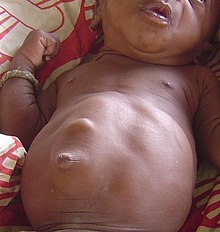| Diastasis recti | |
|---|---|
| Other names | Abdominal separation |
 | |
| Diastasis recti in an infant | |
| Specialty | Pediatrics |

Diastasis recti, or rectus abdominis diastasis, is an increased gap between the right and left rectus abdominis muscles.[1] The increased distance between the muscles is created by the stretching of the linea alba, a connective collagen sheath created by the aponeurosis insertions of the transverse abdominis, internal oblique, and external oblique.[2] This condition has no associated morbidity or mortality. Physical therapy is often required to repair this separation and surgery is an option for more severe cases. Standard exercise rarely results in complete healing of the separated muscles.[3]
Diastasis of the rectus abdominis muscle most frequently occurs in newborns and pregnant women; however, it may occur in any adult woman or man. In the newborn, the rectus abdominis is not fully developed and may not be sealed together at midline. Diastasis recti is more common in premature newborns. In pregnant or postpartum women, the condition is caused by the stretching of the rectus abdominis by the growing uterus. It is more common in multiparous women (women who have had multiple pregnancies) owing to repeated episodes of stretching. When the defect occurs during pregnancy, the uterus can sometimes be seen bulging through the abdominal wall beneath the skin. Non-pregnant women are more susceptible to develop diastasis recti when over the age of 35 or with high birth weight of child, multiple birth pregnancy, or multiple pregnancies. Additional causes can be attributed to excessive abdominal exercises after the first trimester of pregnancy.[4]
Strength training of all the core muscles, including the abdominis recti muscle, may reduce the size of the gap in pregnant or postpartum women. Crunches may increase the diastasis recti separation. All corrective exercises should be in the form of pulling in the abdominal muscles rather than pushing them outwards. In extreme cases diastasis recti is corrected with a cosmetic surgery procedure known as an abdominoplasty by creating a plication, or folding, of the linea alba and suturing it together, which results in a tighter abdominal wall.
- ^ Cite error: The named reference
Reviewwas invoked but never defined (see the help page). - ^ Brauman, Daniel (November 2008). "Diastasis Recti: Clinical Anatomy". Plastic and Reconstructive Surgery. 122 (5): 1564–1569. doi:10.1097/prs.0b013e3181882493. PMID 18971741. S2CID 26635878.
- ^ Norton, Jeffrey A. (2003). Essential practice of surgery: basic science and clinical evidence. Berlin: Springer. pp. 350. ISBN 0-387-95510-0.
- ^ Harms, M.D., Roger W. "Why do abdominal muscles sometimes separate during pregnancy?".